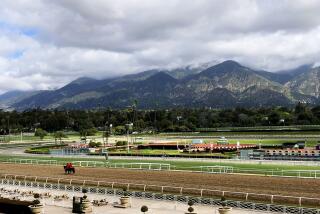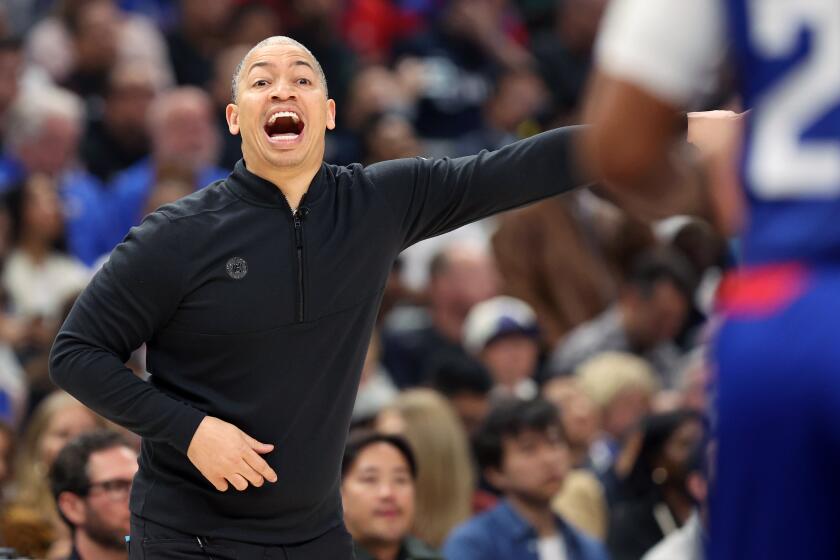Reputation Outweighs Fact at Pimlico : Horse racing: Track is renowned for a speed bias even though recent evidence suggests otherwise.
- Share via
BALTIMORE — Pimlico long has been known as a track that gives a tremendous advantage to front-runners, and even if recent evidence suggests this is not true, the reputation endures. Virtually every trainer preparing a horse for Saturday’s Preakness is mindful of the racing strip’s supposed bias.
Ron McAnally watched speed horses run one-two-three all the way around the track in last week’s Pimlico Special, while his own stretch-runner, Festin, couldn’t get into contention. He observed that speed has been prevailing in most of the races here, and he hopes his quick colt, Olympio, might benefit as a result. But McAnally knows most of his rivals are thinking along the same lines.
“It might look like a quarter-horse race coming out of the gate,” the trainer predicted, “because everybody has the same idea.” And that idea, of course, is to send a horse to the front.
The actions of trainers speak more loudly than their words about the nature of the Pimlico racing surface. When trainers want their horses to display more speed, they rev them up with quick workouts, and there have been a bunch of quick works this week. Honor Grades, a colt who normally comes from far behind, zipped five-eighths of a mile in 58 3-5 seconds. Corporate Report worked in the same time. Hansel sped three furlongs in 34 3-5.
“Everyone’s been drilling,” said Ian Jory, trainer of Kentucky Derby-runnerup Best Pal. “There’s this mass panic to put speed in them, but it’s not going to work. It’s too late to put speed in a horse at this stage.” Jory was confident because he knows Best Pal possesses the natural speed Pimlico demands.
Is this perception of the Pimlico racing strip based on fact or myth?
The track’s reputation was cemented in the 1970s and early 1980s when it was, indeed, the most unfairly biased racing strip in America. There seemed to be an invisible “path” along the rail, and whoever got to this path first -- ordinarily a speed horse breaking from an inside post position -- would usually win. The bias could carry ridiculous horses to victory, and it carried some Preakness winners, too, such as Aloma’s Ruler in 1982.
When the late Frank De Francis took over Pimlico, he worried that this perception of the Preakness as an unfair race was jeopardizing its importance. He hired an ace track superintendent, John Passero, and told him to eradicate the bias. He assured horsemen Pimlico was going to change.
In Passero’s first few months on the job, he may even have overcorrected the bias. Pimlico, amazingly, became a stretch-runners’ track. But for most of the last four years, the track has been a fair one. “We’re trying to keep it nice and deep,” Passero said. “I think we’ve semi-laid to rest the old reputation.”
The contour of the turns at Pimlico still benefits horses on the inside, especially in route races, where horses fanned with on the first turn are placed at a disadvantage. Occasional biases may develop for a day or so, as they do at virtually all tracks, and as apparently happened on the day of the Pimlico Special. But the insuperable biases that used to prevail here are gone forever.
During May, 35 route races have been run at Pimlico, and 16 of them were won by horses rallying from the rear half of the field. But nothing has demonstrated the fairness of the Pimlico strip better than the Preakness itself. In the four years since Passero has been on the job, the race has been captured by Alysheba, Risen Star, Sunday Silence and Summer Squall, all of whom came from off the pace. Indeed, the front-runners have faded badly every year.
But the facts don’t make a dent in Pimlico’s image. Before last year’s race, the Daily Racing Form declared, “The Pimlico strip has never been faster or more biased toward speed.” This year, again, similar sentiments abound.
When trainers and jockeys become preoccupied by the notion that this is a highly speed-favoring track, horses in the Preakness are sometimes gunned for the lead with such abandon that they kill each other and set up the race for a stretch-runner.
(That’s what happened in 1985, when Chief’s Crown pushed Eternal Prince through six furlongs in a breathtaking 1:09 2-5 and handed the race to the late-running Tank’s Prospect.)
Given the fact that Olympio, Best Pal, Corporate Report, Mane Minister and Hansel all possess good speed, they conceivably could do a favor for the one formidable stretch-runner in the field, Strike the Gold.
More to Read
Go beyond the scoreboard
Get the latest on L.A.'s teams in the daily Sports Report newsletter.
You may occasionally receive promotional content from the Los Angeles Times.










